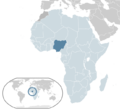Difference between revisions of "Nigeria Energy Situation"
***** (***** | *****) |
***** (***** | *****) |
||
| Line 7: | Line 7: | ||
= Introduction = | = Introduction = | ||
Nigeria is a federal republic comprising 36 states and the Federal Capital Territory. The country has a surface of nearly 1 million km2 and a population of about 170 million growing at an average of 2% annually. The economy, heavily dependent on the export of oil products, grows at an average of 6% annually. The country enjoys a tropical climate in the south and central belt and an arid/semi-arid climate in the north. It is endowed with vast natural resources; oil and gas, solar (particularly in the north), hydropower (incl. 277 small hydro identified sites with a cumulative potential of 3,500 MW) and wind (mainly in the north and along the coastal line). | Nigeria is a federal republic comprising 36 states and the Federal Capital Territory. The country has a surface of nearly 1 million km2 and a population of about 170 million growing at an average of 2% annually. The economy, heavily dependent on the export of oil products, grows at an average of 6% annually. The country enjoys a tropical climate in the south and central belt and an arid/semi-arid climate in the north. It is endowed with vast natural resources; oil and gas, solar (particularly in the north), hydropower (incl. 277 small hydro identified sites with a cumulative potential of 3,500 MW) and wind (mainly in the north and along the coastal line). | ||
| + | |||
| Line 12: | Line 13: | ||
= Energy Situation = | = Energy Situation = | ||
| − | According to the statistics from the International Energy Agency (IEA), total Nigerian primary energy supply was 118,325 ktoe (excluding electricity trade) in 2011. As depicted in the figure below, biomass and waste dominated with 82.2%. Renewable energy sources only accounted for a small share of the energy supply. For instance hydropower only accounted for 0.4%< | + | According to the statistics from the International Energy Agency (IEA), total Nigerian primary energy supply was 118,325 ktoe (excluding electricity trade) in 2011. As depicted in the figure below, biomass and waste dominated with 82.2%. Renewable energy sources only accounted for a small share of the energy supply. For instance hydropower only accounted for 0.4%[[#_ftn1|[1]]]. Wind and solar are also utilized, but at a negligible level at present. |
| + | <div><br/>---- | ||
| + | <div id="ftn1">[[#_ftnref1|[1]]] Nigerian Energy Support Programme, 2014, The Nigerian Energy Sector - an Overview with a Special Emphasis on Renewable Energy, Energy Efficiency and Rural Electrification quoting IEA, 2013: [http://www.iea.org/statistics/topics/Electricity/ http://www.iea.org/statistics/topics/Electricity/] | ||
| + | </div></div> | ||
Revision as of 13:50, 10 February 2015
Capital:
Abuja
Region:
Coordinates:
8.0000° N, 10.0000° E
Total Area (km²): It includes a country's total area, including areas under inland bodies of water and some coastal waterways.
923,770
Population: It is based on the de facto definition of population, which counts all residents regardless of legal status or citizenship--except for refugees not permanently settled in the country of asylum, who are generally considered part of the population of their country of origin.
223,804,632 (2023)
Rural Population (% of total population): It refers to people living in rural areas as defined by national statistical offices. It is calculated as the difference between total population and urban population.
46 (2023)
GDP (current US$): It is the sum of gross value added by all resident producers in the economy plus any product taxes and minus any subsidies not included in the value of the products. It is calculated without making deductions for depreciation of fabricated assets or for depletion and degradation of natural resources.
362,814,951,696 (2023)
GDP Per Capita (current US$): It is gross domestic product divided by midyear population
1,621.12 (2023)
Access to Electricity (% of population): It is the percentage of population with access to electricity.
60.50 (2022)
Energy Imports Net (% of energy use): It is estimated as energy use less production, both measured in oil equivalents. A negative value indicates that the country is a net exporter. Energy use refers to use of primary energy before transformation to other end-use fuels, which is equal to indigenous production plus imports and stock changes, minus exports and fuels supplied to ships and aircraft engaged in international transport.
-93.03 (2014)
Fossil Fuel Energy Consumption (% of total): It comprises coal, oil, petroleum, and natural gas products.
18.88 (2014)
Introduction
Nigeria is a federal republic comprising 36 states and the Federal Capital Territory. The country has a surface of nearly 1 million km2 and a population of about 170 million growing at an average of 2% annually. The economy, heavily dependent on the export of oil products, grows at an average of 6% annually. The country enjoys a tropical climate in the south and central belt and an arid/semi-arid climate in the north. It is endowed with vast natural resources; oil and gas, solar (particularly in the north), hydropower (incl. 277 small hydro identified sites with a cumulative potential of 3,500 MW) and wind (mainly in the north and along the coastal line).
Energy Situation
According to the statistics from the International Energy Agency (IEA), total Nigerian primary energy supply was 118,325 ktoe (excluding electricity trade) in 2011. As depicted in the figure below, biomass and waste dominated with 82.2%. Renewable energy sources only accounted for a small share of the energy supply. For instance hydropower only accounted for 0.4%[1]. Wind and solar are also utilized, but at a negligible level at present.
----
References






















